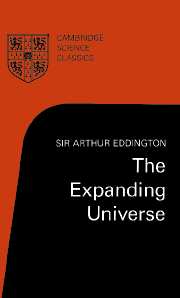CHAPTER III - Features of the Expanding Universe
Published online by Cambridge University Press: 15 December 2009
Summary
The world's a bubble, and the life of man
Less than a span.
Francis BaconA spherical world, closed but continually expanding, is a new playground for thought. Let us play in it a little to familiarise ourselves with it. In this chapter I shall mix together results which may prove to be of scientific importance and results that are probably no more than mathematical curiosities. The plan is to set down anything that seems worthy of note, even though we cannot see that it has any ultimate importance in nature.
For a model of the universe let us represent spherical space by a rubber balloon. Our three dimensions of length, breadth and thickness ought all to lie in the skin of the balloon; but there is only room for two, so the model will have to sacrifice one of them. That does not matter very seriously. Imagine the galaxies to be embedded in the rubber. Now let the balloon be steadily inflated. That's the expanding universe.
The galaxies are supposed to be scattered more or less evenly over the surface; our observational knowledge, however, is limited to a portion which corresponds roughly to the size of France on a terrestrial globe. The galaxies have individual motions, i.e. motions with respect to the material of the balloon, but these are comparatively small; in the main they recede from one another simply by the stretching of the rubber.
- Type
- Chapter
- Information
- The Expanding UniverseAstronomy's 'Great Debate', 1900–1931, pp. 66 - 92Publisher: Cambridge University PressPrint publication year: 1920



